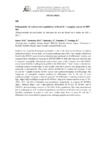Use este identificador para citar ou linkar para este item:
http://www.alice.cnptia.embrapa.br/alice/handle/doc/934265| Título: | Pathogenicity of soybean rust populations in Brazil 4 cropping seasons 2007 - 2011. |
| Autoria: | SOARES, R. M.  AKAMATSU, H. O.   YAMANAKA, N.   YAMAOKA, Y.   SUENAGA, K.   |
| Afiliação: | RAFAEL MOREIRA SOARES, CNPSO; HAJIME O. AKAMATSU, JIRCAS; NAOKI YAMANAKA, JIRCAS; YUICHI YAMAOKA, University of Tsukuba; KAZUHIRO SUENAGA, JIRCAS. |
| Ano de publicação: | 2012 |
| Referência: | CONGRESSO BRASILEIRO DE FITOPATOLOGIA, 45., 2012, Manaus. [Anais...]. Tropical Plant Pathology, Brasília, DF, v. 37, Aug. 2012. Suplemento. Trab. 358, Micologia. 1 CD-ROM. Fito 2012. |
| Conteúdo: | Soybean rust caused by Phakopsora pachyrhizi is one of the most serious threats to soybean production in Brazil. In this study, we evaluated pathogenicity of the 7 rust samples collected in Brazil in the 2010/11 season based on infection types produced on 16 differential varieties, and compared them with those in 3 seasons of 2007/08?2009/10. When the data were classified into 3 categories: susceptible, intermediate, and resistant, none of the 7 samples from the 2010/11 season showed identical pathogenicity profile in the differentials. Cluster analysis and principal coordinate analysis revealed that 31 rust samples from the 4 seasons vary geographically and temporally in pathogenicity. The cluster analysis divided the 31 samples into 2 groups (A and B), and the 7 samples from the 2010/11 season were scattered throughout in both groups. The frequencies of susceptible reaction produced in differentials 3?6, 9, 10, and 12 were significantly higher for group A than for group B. The differentials containing resistance genes Rpp1, Rpp2, Rpp3 and Rpp4, except for PI 587880A, displayed resistant reaction to only <13%, <39%, 23%, and 38% of Brazilian rust populations, respectively. In contrast, PI 587880A (Rpp1), Shiranui (Rpp5), and 3 Rpp-unknown differentials PI 587855, PI 587905, and PI 594767A, showed resistant reaction to 74%?96% of the populations. This study demonstrated that (i) pathogenicity of P. pachyrhizi populations was diverse in Brazil in the 4 seasons, (ii) Brazilian populations of group A were more virulent than those of group B, and (iii) 5 differentials have been effective against recent pathogen populations in the country. |
| Palavras-chave: | Fitopatologia |
| Tipo do material: | Resumo em anais e proceedings |
| Acesso: | openAccess |
| Aparece nas coleções: | Resumo em anais de congresso (CNPSO)  |
Arquivos associados a este item:
| Arquivo | Descrição | Tamanho | Formato | |
|---|---|---|---|---|
| patogenicity.fito2012.rafael.pdf | 142,95 kB | Adobe PDF |  Visualizar/Abrir |









